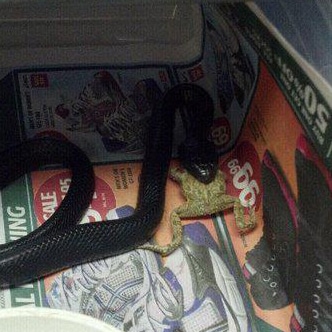Several years ago, I worked incubating, hatching, and raising Eastern Indigo snakes (Drymarchon couperi) for a head start and release program in Alabama. It was the most rewarding work I’ve ever done, allowing me to work with what I consider the most impressive snake in this part of the world while contributing to its conservation. I was a small part of a large project involving Auburn University, Zoo Atlanta, the Orianne Society, and several state and federal agencies.
The Eastern Indigo Snake is one of the largest snakes in North America, reaching nearly three meters in length. They are non-venomous generalist predators, meaning they eat almost any prey that fits in their mouths. Unlike many non-venomous snakes in the pet trade, they are not constrictors; they kill prey through brute force. An adult can kill a large Eastern diamondback rattlesnake by crushing its head and swallowing it whole. Juveniles primarily eat other snakes, rodents, and anurans (frogs and toads), while adults also consume baby gopher tortoises. These snakes were once found in southern Alabama but became locally extinct due to habitat loss, rattlesnake roundups (burrow gassing), and collection for the pet trade. They inhabit gopher tortoise burrows in the long-leaf pine forests of Florida, Georgia, and now again Alabama. During my time on the project, we hatched and raised nearly 200 snakes for conservation. My role included incubating eggs and feeding hatchlings for several months before they were sent to Zoo Atlanta for head-starting and eventual release. With years of reptile experience as a hobbyist and zookeeper, I knew reptile husbandry but was new to scientific methods. While incubating eggs and feeding the snakes, I learned the importance of data recording, guided by knowledgeable colleagues. We meticulously recorded weight, species, and number of prey items for every meal for every snake over several years. To prepare them for wild release, we fed a diet as close to natural as possible, including rodents, snakes, frogs, toads, baby quail, fish, skinks, anoles, fence lizards, and hatchling turtles. As many know, baby snakes can be finicky; some refused most prey types and preferred only one particular flavor. Indigo Snake Information Breeding the Eastern Indigo Snake Climbing A Tree to Save an Eastern Indigo Snake Drymarchon couperi An indigo snake guarding its eggs. mike winesSome snakes eagerly consume anything that moves, even accidentally biting fingers. After years of data collection and raising these fascinating creatures, I accumulated extensive knowledge. I decided to apply this information professionally. The herpetology professor at Auburn University (War Eagle) offered me a lab position to pursue a master’s degree, where I learned scientific methods, statistics, and endured challenging yet rewarding experiences. Ultimately, I completed a thesis published in Zoo Biology (referenced at the end).
Through research, we discovered that snakes with a more diverse diet grew faster than those on a less varied diet, despite identical food weight intake (Wines et al. 2015). Additionally, we determined optimal egg incubation temperatures, which will be detailed in a future article. This creates an intriguing cliffhanger for reptile enthusiasts. What does diet diversity mean for your snake husbandry practices? Should you alter your snake’s diet? Generally, changes may be minimal. Indigo Snakes in the study were raised for release, whereas captive snakes don’t require natural diets since they aren’t returning to the wild. Many keepers have years of successful experience. However, occasionally offering different prey items can be beneficial, though specialist species like egg-eating snakes have specific dietary needs and are exceptions. I recommend feeding pre-killed, frozen prey to avoid parasites and injury risks. If you typically feed mice, consider occasionally offering frozen chicks or quail. Always prioritize humane practices by freezing prey after euthanasia. Evaluate your snake collection: Identify any struggling individuals. Research their wild diet and find suitable food sources. Ideally, this research should occur before acquiring a captive-bred snake. Pet store advice may be unreliable; consult experienced breeders who have raised multiple generations. Stick with proven methods but refine diets as needed—your snake will benefit. Reference: Wines, M. P., Johnson, V. M., Lock, B., Antonio, F., Godwin, J. C., Rush, E. M. and Guyer, C. (2015), Optimal husbandry of hatchling Eastern Indigo Snakes (Drymarchon couperi) during a captive head-start program.Reference: Zoo Biol., 34: 230–238.



